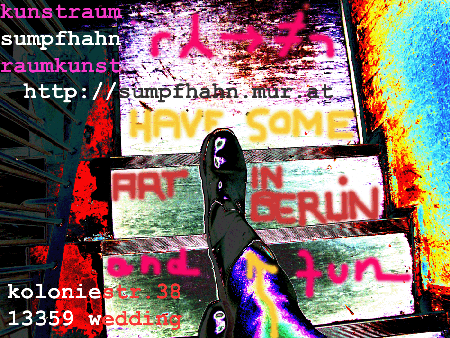|
The history of its
origins already reflects this, and through its location [Koloniestrasse 38/Wedding] there is consciously put a statement
against conventional, uncoupled from the spectator, experience of art.
From the beginning the sumpfhahn was perceived by the inhabitants of the Kiez as a social
room. By means of their support a room is just come into being where not only own
[artistical] ideas can be realized, but where is also a meeting-place of the Kiez
being about to be created.Artists, who had never seen themselves as artists till now,
are motivated to show their work in the public. Art should not be confined to passive
consumption, but quite on contrary should happen under active participation of the environment,
what means that the sumpfhahn is also a product of the residents of the Koloniestrasse
respectively the people of the Kiez and of the atmosphere in Wedding.That it is not dominated
by harmony, has not to be specially said. After all art should indeed not only happen in the
'protected' room of a studio or of a museum, but exactly there where people live. The social
environment is only one determinant of the artroom_sumpfhahn. Areas of tension shall develop
through external art and artists, because there will be invited artists all over the EU-area.
There is the duty to use available resources, also to try to get to the bottom of it and
possibly to reject it, to reflect on new things or to respect them at least. |
